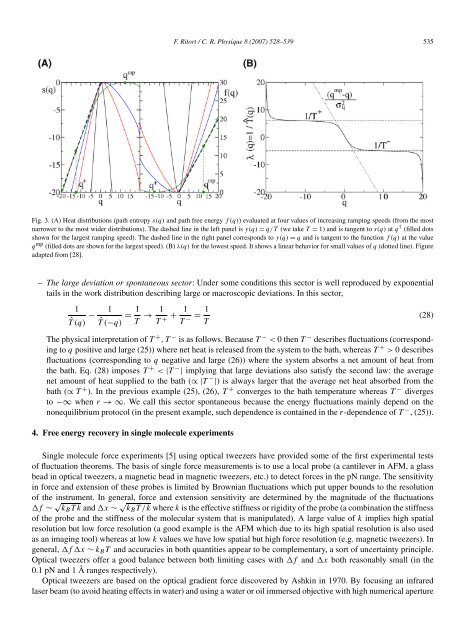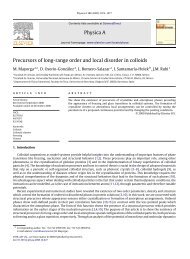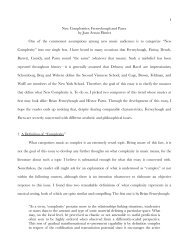The nonequilibrium thermodynamics of small systems
The nonequilibrium thermodynamics of small systems
The nonequilibrium thermodynamics of small systems
Create successful ePaper yourself
Turn your PDF publications into a flip-book with our unique Google optimized e-Paper software.
F. Ritort / C. R. Physique 8 (2007) 528–539 535Fig. 3. (A) Heat distributions (path entropy s(q) and path free energy f(q)) evaluated at four values <strong>of</strong> increasing ramping speeds (from the mostnarrower to the most wider distributions). <strong>The</strong> dashed line in the left panel is y(q) = q/T (we take T = 1) and is tangent to s(q) at q † (filled dotsshown for the largest ramping speed). <strong>The</strong> dashed line in the right panel corresponds to y(q) = q and is tangent to the function f(q)at the valueq mp (filled dots are shown for the largest speed). (B) λ(q) for the lowest speed. It shows a linear behavior for <strong>small</strong> values <strong>of</strong> q (dotted line). Figureadapted from [28].– <strong>The</strong> large deviation or spontaneous sector: Under some conditions this sector is well reproduced by exponentialtails in the work distribution describing large or macroscopic deviations. In this sector,1ˆT(q) − 1ˆT(−q) = 1 T → 1T + + 1T − = 1 T(28)<strong>The</strong> physical interpretation <strong>of</strong> T + ,T − is as follows. Because T − < 0 then T − describes fluctuations (correspondingto q positive and large (25)) where net heat is released from the system to the bath, whereas T + > 0 describesfluctuations (corresponding to q negative and large (26)) where the system absorbs a net amount <strong>of</strong> heat fromthe bath. Eq. (28) imposes T + < |T − | implying that large deviations also satisfy the second law: the averagenet amount <strong>of</strong> heat supplied to the bath (∝ |T − |) is always larger that the average net heat absorbed from thebath (∝ T + ). In the previous example (25), (26), T + converges to the bath temperature whereas T − divergesto −∞ when r →∞. We call this sector spontaneous because the energy fluctuations mainly depend on the<strong>nonequilibrium</strong> protocol (in the present example, such dependence is contained in the r-dependence <strong>of</strong> T − , (25)).4. Free energy recovery in single molecule experimentsSingle molecule force experiments [5] using optical tweezers have provided some <strong>of</strong> the first experimental tests<strong>of</strong> fluctuation theorems. <strong>The</strong> basis <strong>of</strong> single force measurements is to use a local probe (a cantilever in AFM, a glassbead in optical tweezers, a magnetic bead in magnetic tweezers, etc.) to detect forces in the pN range. <strong>The</strong> sensitivityin force and extension <strong>of</strong> these probes is limited by Brownian fluctuations which put upper bounds to the resolution<strong>of</strong> the instrument. In general, force and extension sensitivity are determined by the magnitude <strong>of</strong> the fluctuationsf ∼ √ k B Tkand x ∼ √ k B T/kwhere k is the effective stiffness or rigidity <strong>of</strong> the probe (a combination the stiffness<strong>of</strong> the probe and the stiffness <strong>of</strong> the molecular system that is manipulated). A large value <strong>of</strong> k implies high spatialresolution but low force resolution (a good example is the AFM which due to its high spatial resolution is also usedas an imaging tool) whereas at low k values we have low spatial but high force resolution (e.g. magnetic tweezers). Ingeneral, f x ∼ k B T and accuracies in both quantities appear to be complementary, a sort <strong>of</strong> uncertainty principle.Optical tweezers <strong>of</strong>fer a good balance between both limiting cases with f and x both reasonably <strong>small</strong> (in the0.1 pN and 1 Å ranges respectively).Optical tweezers are based on the optical gradient force discovered by Ashkin in 1970. By focusing an infraredlaser beam (to avoid heating effects in water) and using a water or oil immersed objective with high numerical aperture





